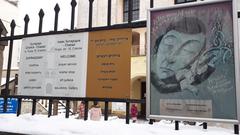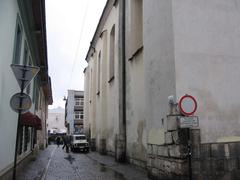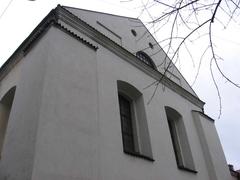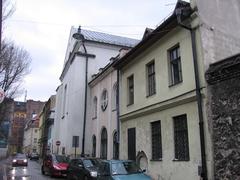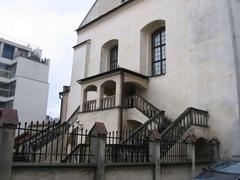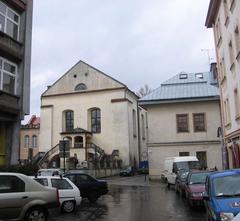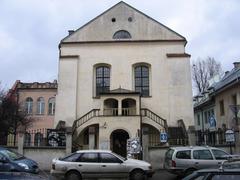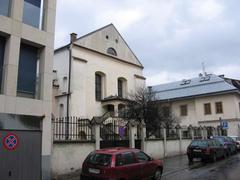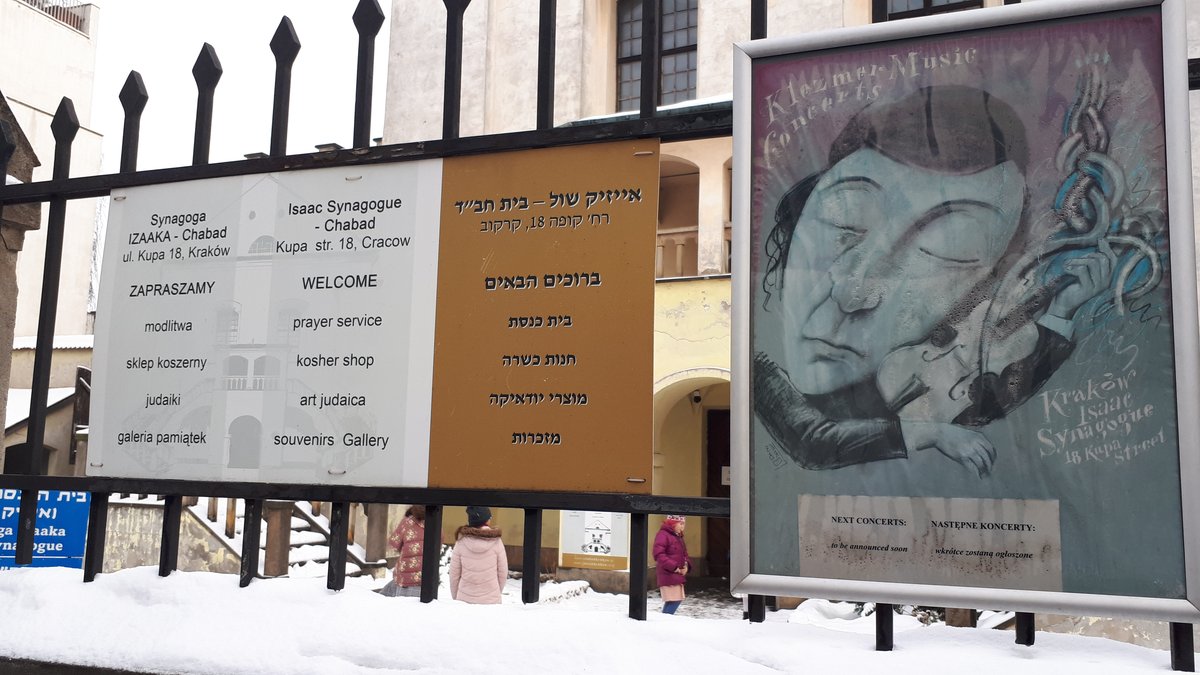
Izaak Synagogue Visiting Hours, Tickets, and Kraków Historical Sites Guide
Date: 15/06/2025
Introduction
Nestled in Kraków’s historic Kazimierz district, the Izaak Synagogue (Synagoga Izaaka Jakubowicza) represents a remarkable chapter of Poland’s Jewish heritage. Founded in 1644 by Isaac Jakubowicz, a distinguished banker and royal purveyor, the synagogue stands as a testament to both architectural grandeur and the enduring spirit of Kraków’s Jewish community. Its Baroque and Mannerist features, conceived by Italian architects like Francesco Olivierri, make it one of the most architecturally significant synagogues in the region (Encyclopedia of Jewish History, Jewish Virtual Library).
Inside, visitors are greeted by a vaulted barrel ceiling, ornate stuccoes, a gilded Aron Kodesh (Holy Ark), and a centrally located bimah, all serving as reminders of the synagogue’s role as a spiritual, cultural, and social hub for centuries (Culture.pl). Despite the devastation of World War II, the Izaak Synagogue has undergone significant restoration, ensuring its stories and beauty are preserved for future generations (Kraków Tourism Board, United States Holocaust Memorial Museum).
This comprehensive guide details the synagogue’s history, architectural highlights, visiting hours, ticketing, accessibility, nearby attractions, and travel tips—offering everything you need for an enriching visit to one of Kraków’s most treasured historical sites.
Table of Contents
- Introduction
- History and Foundation
- Architectural Features
- Role in the Jewish Community
- WWII Destruction and Postwar Restoration
- Visiting the Izaak Synagogue
- Travel Information and Nearby Attractions
- Visitor Experience and Practical Tips
- Frequently Asked Questions (FAQ)
- Conclusion and Further Resources
History and Foundation
The Izaak Synagogue was commissioned in 1644 by Isaac Jakubowicz, a prominent banker and philanthropist, during a flourishing period for Kraków’s Jewish community (Encyclopedia of Jewish History). Situated in Kazimierz—then a major center of Jewish life—the synagogue quickly became a vital gathering place for worship, study, and community affairs.
Its foundation reflects not only the prosperity of Kraków’s Jews but also their resilience. The synagogue’s construction was challenged by local opposition due to its size and grandeur, but royal support enabled its completion.
Architectural Features
Exterior
The Izaak Synagogue’s exterior is a robust example of Polish Mannerist style, bridging late Renaissance and Baroque periods. Its rectangular form, thick masonry walls, and gabled tiled roof convey both strength and permanence. The façade features a simple stone portal crowned with a Hebrew inscription honoring the founder, and small arched windows provide security and natural light (Jewish Virtual Library).
Interior
Inside, the sanctuary is characterized by a spacious, basilica-like layout with three aisles divided by sturdy pillars. The barrel-vaulted ceiling is adorned with intricate stucco and painted decorations—floral motifs, geometric patterns, and Jewish symbols such as the Star of David (Virtual Shtetl). The Aron Kodesh (Holy Ark) is a Baroque masterpiece, gilded and embellished with symbolic carvings, including lions and Hebrew inscriptions (Culture.pl). The centrally positioned bimah, with decorative railings and steps, underscores the centrality of communal worship.
The synagogue’s walls were once covered with biblical verses and symbolic artwork, much of which was damaged during WWII but is being meticulously restored.
Role in the Jewish Community
The Izaak Synagogue served as a spiritual heart for Kraków’s Jewish elite, hosting daily prayers, Torah readings, bar mitzvahs, weddings, and funerals. Its women’s gallery and Tzedakah (charity) box are testaments to its community focus (Polish Jewish Heritage Foundation). The synagogue also played a role in social and charitable activities, fostering a strong sense of communal identity.
WWII Destruction and Postwar Restoration
During the Nazi occupation, the synagogue was desecrated, repurposed as a warehouse, and stripped of its sacred objects (United States Holocaust Memorial Museum). After years of neglect, restoration efforts began in the 1980s, focusing on architectural and artistic rehabilitation. Today, the synagogue stands both as a place of worship and a poignant memorial to Kraków’s lost Jewish community (Virtual Shtetl).
Visiting the Izaak Synagogue
Hours and Tickets
- Opening Hours: Generally Tuesday to Sunday, 10:00 AM–4:00 PM; closed Mondays and Jewish holidays. Some sources note extended hours in summer (up to 6:00 PM), so always check the latest schedule (Kraków Tourism Board).
- Tickets: Standard tickets cost 10–15 PLN (approx. 2.5–4 USD) for adults, with discounts for students, seniors, and groups. Children under a certain age may enter free. Tickets can be purchased onsite or online.
Accessibility
- The synagogue is wheelchair accessible, though some historic features (cellars, stairs to the women’s gallery) may be difficult to access.
- Ramps and handrails are installed, and staff can assist as needed.
- If you have mobility needs, contact the site in advance for arrangements.
Guided Tours and Events
- Guided tours are available daily in multiple languages and can be booked in advance.
- Special events, concerts, and cultural programs are occasionally hosted—visit the synagogue’s or Kraków’s official tourism website for current schedules.
Travel Information and Nearby Attractions
Location and Getting There
- Address: ul. Kupa 16, Kazimierz, Kraków.
- Easily reached by foot from Old Town (20-minute walk), or by trams and buses stopping at Plac Wolnica or Miodowa.
- Limited parking; public transport recommended.
Nearby Attractions
- Remuh Synagogue and Cemetery
- Old Synagogue
- Galicia Jewish Museum
- Jewish Community Centre
- Plac Nowy (for cafes, street food, and markets)
A full day in Kazimierz can include multiple synagogues, museums, local restaurants, and vibrant street life (Kraków Travel).
Visitor Experience and Practical Tips
Dress Code and Etiquette
- Modest attire is required. Men may be asked to wear a kippah (provided at the entrance).
- Shoulders and knees should be covered.
- Photography is allowed unless restricted during services or special events.
- Maintain respectful silence and refrain from eating or drinking inside.
Facilities
- Restroom facilities are limited inside; public toilets are nearby.
- No cloakroom; travel light.
- Numerous cafes and restaurants are within walking distance, including at Izaak Jakubowicz’s former residence at 7 Izaaka Street (Kraków Travel).
Accessibility and Safety
- Some areas (cellars, women’s gallery) may be less accessible.
- Security personnel may conduct bag checks; carry ID and comply with instructions.
Practical Travel Tips
- Kazimierz’s streets are cobbled; wear comfortable shoes.
- The synagogue is heated, but the cellars may be cool.
- Summer months are busiest; visit early or late for fewer crowds.
Language
- Staff and informational materials are in Polish and English; guided tours may be available in other languages.
Social Media
- Photography for personal use is permitted; tag the location and use official hashtags to support awareness.
Frequently Asked Questions (FAQ)
What are the Izaak Synagogue’s visiting hours?
Typically, Tuesday–Sunday, 10:00 AM–4:00 PM (or 6:00 PM in summer); closed Mondays and Jewish holidays.
How much are tickets?
10–15 PLN for adults; discounts for students, seniors, and groups. Free for children under a certain age.
Are guided tours available?
Yes, in multiple languages; book on-site or in advance.
Is the synagogue wheelchair accessible?
Yes, for most areas; contact ahead for additional needs.
Can I take photos inside?
Yes, but respect restrictions during services and avoid flash or tripods.
Are there nearby attractions?
Yes—Remuh Synagogue, Old Synagogue, Galicia Jewish Museum, and the vibrant streets of Kazimierz.
Conclusion and Further Resources
The Izaak Synagogue is a centerpiece of Kraków’s Jewish heritage, blending centuries of history, artistry, and resilience. Whether you are drawn by architecture, history, spirituality, or culture, your visit will be rewarding and meaningful. For the best experience, check visiting hours, consider a guided tour, and explore the wider Kazimierz district.
Plan your visit today—download the Audiala app for interactive maps, expert commentary, and event updates. Support preservation by purchasing tickets and sharing your experience respectfully.
Official Sources and Further Reading
- Kraków Tourism Board
- Jewish Virtual Library
- Polish Jewish Heritage Foundation
- Kraków Travel
- United States Holocaust Memorial Museum
- Virtual Shtetl
- Culture.pl
